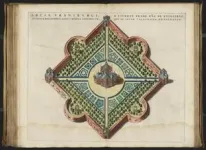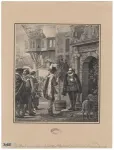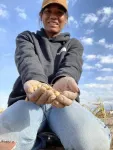(Press-News.org) In the Middle Ages, alchemists were notoriously secretive and didn’t share their knowledge with others. Danish Tycho Brahe was no exception. Consequently, we don’t know precisely what he did in the alchemical laboratory located beneath his combined residence and observatory, Uraniborg, on the now Swedish island of Ven.
Only a few of his alchemical recipes have survived, and today, there are very few remnants of his laboratory. Uraniborg was demolished after his death in 1601, and the building materials were scattered for reuse.
However, during an excavation in 1988-1990, some pottery and glass shards were found in Uraniborg’s old garden. These shards were believed to originate from the basement’s alchemical laboratory. Five of these shards—four glass and one ceramic—have now undergone chemical analyses to determine which elements the original glass and ceramic containers came into contact with.
The chemical analyses were conducted by Professor Emeritus and expert in archaeometry, Kaare Lund Rasmussen from the Department of Physics, Chemistry, and Pharmacy, University of Southern Denmark. Senior researcher and museum curator Poul Grinder-Hansen from the National Museum of Denmark oversaw the insertion of the analyses into historical context.
Enriched levels of trace elements were found on four of them, while one glass shard showed no specific enrichments. The study has been published in the journal Heritage Science (link to be provided).
"Most intriguing are the elements found in higher concentrations than expected—indicating enrichment and providing insight into the substances used in Tycho Brahe’s alchemical laboratory", said Kaare Lund Rasmussen.
The enriched elements are nickel, copper, zinc, tin, antimony, tungsten, gold, mercury, and lead, and they have been found on either the inside or outside of the shards.
Most of them are not surprising for an alchemist's laboratory. Gold and mercury were – at least among the upper echelons of society – commonly known and used against a wide range of diseases.
"But tungsten is very mysterious. Tungsten had not even been described at that time, so what should we infer from its presence on a shard from Tycho Brahe's alchemy workshop?", said Kaare Lund Rasmussen.
Tungsten was first described and produced in pure form more than 180 years later by the Swedish chemist Carl Wilhelm Scheele. Tungsten occurs naturally in certain minerals, and perhaps the element found its way to Tycho Brahe's laboratory through one of these minerals. In the laboratory, the mineral might have undergone some processing that separated the tungsten, without Tycho Brahe ever realizing it.
However, there is also another possibility that Professor Kaare Lund Rasmussen emphasizes has no evidence whatsoever – but which could be plausible.
Already in the first half of the 1500s, the German mineralogist Georgius Agricola described something strange in tin ore from Saxony, which caused problems when he tried to smelt tin. Agricola called this strange substance in the tin ore "Wolfram” (German for Wolf’s froth, later renamed to tungsten in English).
"Maybe Tycho Brahe had heard about this and thus knew of tungsten's existence. But this is not something we know or can say based on the analyses I have done. It is merely a possible theoretical explanation for why we find tungsten in the samples", said Kaare Lund Rasmussen.
Tycho Brahe belonged to the branch of alchemists who, inspired by the German physician Paracelsus, tried to develop medicine for various diseases of the time: plague, syphilis, leprosy, fever, stomach aches, etc. But he distanced himself from the branch that tried to create gold from less valuable minerals and metals.
In line with the other medical alchemists of the time, he kept his recipes close to his chest and shared them only with a few selected individuals, such as his patron, Emperor Rudolph II, who allegedly received Tycho Brahe's prescriptions for plague medicine.
We know that Tycho Brahe's plague medicine was complicated to produce. It contained theriac, which was one of the standard remedies for almost everything at the time and could have up to 60 ingredients, including snake flesh and opium. It also contained copper or iron vitriol (sulphates), various oils, and herbs.
After various filtrations and distillations, the first of Brahe's three recipes against plague was obtained. This could be made even more potent by adding tinctures of, for example, coral, sapphires, hyacinths, or potable gold.
"It may seem strange that Tycho Brahe was involved in both astronomy and alchemy, but when one understands his worldview, it makes sense. He believed that there were obvious connections between the heavenly bodies, earthly substances, and the body's organs. Thus, the Sun, gold, and the heart were connected, and the same applied to the Moon, silver, and the brain; Jupiter, tin, and the liver; Venus, copper, and the kidneys; Saturn, lead, and the spleen; Mars, iron, and the gallbladder; and Mercury, mercury, and the lungs. Minerals and gemstones could also be linked to this system, so emeralds, for example, belonged to Mercury", explained Poul Grinder-Hansen.
Kaare Lund Rasmussen has previously analyzed hair and bones from Tycho Brahe and found, among other elements, gold. This could indicate that Tycho Brahe himself had taken medicine that contained potable gold.
Journal: Heritage Science.
Title: Chemical analysis of fragments of glass and ceramic ware from Tycho Brahe’s laboratory at Uraniborg on the island of Ven (Sweden).
Authors: Kaare Lund Rasmussen, University of Southern Denmark and Poul Grinder-Hansen, National Museum of Denmark.
Kaare Lund Rasmussen is a professor emeritus at the Department of Physics, Chemistry, and Pharmacy, University of Southern Denmark. He is an expert in chemical investigations of cultural heritage artefacts. He has conducted analyses of the Dead Sea Scrolls, the coffin of King Canute the Holy, and the skeletons of Jesus’ apostles.
About the chemical analyses: Four shards of glass and a shard from a crucible were analyzed. The following elements were found on the outer or inner surfaces and are not enriched: sodium, silicon, phosphorus, sulfur, chlorine, potassium, manganese, iron, rubidium, strontium, rhodium, palladium, silver, cadmium, barium, rhenium, osmium, iridium, platinum, and thallium. The following enriched elements were found: nickel, copper, zinc, tin, antimony, tungsten, gold, mercury, and lead.
Tycho Brahe’s alchemical laboratory: The laboratory in the basement measured 11.3 meters in diameter and contained 16 furnaces, used for heating substances, producing ash, distillation, etc. Some of the large distillation vessels had copper pipes that ran outdoors for cooling and then back inside. A spiral staircase led up to the Winter Room, which served as the Brahe family’s living room, and it had an additional five furnaces for experiments.
Media contact
Professor Emeritus Kaare Lund Rasmussen, Department of Physics, Chemistry and Pharmacy, University of Southern Denmark. Email: klr@sdu.dk. Phone: +45 2371 3709.
Press officer Birgitte Svennevig, Faculty of Science, University of Southern Denmark. Email: birs@sdu.dk. Phone: +45 2759 8679.
END
Chemical analyses find hidden elements from renaissance astronomer Tycho Brahe’s alchemy laboratory
2024-07-25
ELSE PRESS RELEASES FROM THIS DATE:
Pacific Northwest launches clean hydrogen energy hub
2024-07-25
RICHLAND, Wash.—The Pacific Northwest is set to begin work building out a clean hydrogen economy with today’s announcement of a Phase 1 funding award from the Department of Energy. The $27.5 million award to the Pacific Northwest Hydrogen Association (PNWH2), a multi-state nonprofit organization, will be matched by industry partners up to $125 million in Phase 1 of the project.
DOE’s Pacific Northwest National Laboratory will serve as an advisor to the PNWH2 by conducting life-cycle analysis to predict and understand the planned hydrogen energy infrastructure impact on decreasing emissions and aiding in community engagement.
Public ...
Tiny deletion in heart muscle protein briefly affects embryonic ventricles but has long-term effects on adult atrial fibrillation
2024-07-25
BIRMINGHAM, Ala. – Millions of adults have atrial fibrillation — an irregular beating of the upper chambers of the heart that yields increased risk of heart failure, stroke and death. Many genetic mutations in the developing fetus can lead to adult atrial fibrillation, including mutations that shorten the massive protein titin in cardiac muscle cells.
Now, in a study in zebrafish and human heart muscle cells, researchers show that a tiny deletion in the A-band of titin — the loss of just nine amino acids out of more than 27,000 to 35,000 amino acids of an intact titin protein — causes a developmental ...
Harms of prescribing NSAIDs to high risk groups estimated to cost NHS £31m over 10 years
2024-07-25
Prescribing non-steroidal anti-inflammatory drugs (NSAIDs) to people at high risk of harm from them is estimated to cost the NHS in England around £31 million and cause more than 6,000 lost years of good health over 10 years, finds a study published by The BMJ today.
NSAIDs continue to be a source of avoidable harm and healthcare costs, and more needs to be done to address this, especially in high risk groups, say the researchers.
NSAIDs are used for pain and inflammation and are one of the most widely prescribed groups of medicines in the world, But they are known to increase the risk of gastrointestinal bleeding, heart attacks, stroke, and kidney damage.
Yet ...
Wearing a face mask in public spaces cuts risk of common respiratory symptoms, suggests Norway study
2024-07-25
Wearing a surgical face mask in public spaces reduces the risk of self-reported respiratory symptoms, finds a trial of adults in Norway published by The BMJ today.
The effect was moderate - a 3.2% reduction in symptoms, equivalent to around 3,300 fewer infections per 100,000 people - but the researchers say these results support the claim that face masks may be an effective measure to reduce the rate of self-reported symptoms consistent with respiratory tract infections.
Observational studies suggest that face masks reduce the risk of respiratory tract infections, but findings from randomised ...
Some private biobanks overinflating the value of umbilical cord blood banking in marketing to expectant parents
2024-07-25
Some private UK biobanks may be misleading expectant parents about the value of storing umbilical cord blood to treat life-threatening diseases that may arise in their child in the future, reveals an investigation by The BMJ, published today.
Over the past decade growing numbers of parents have chosen to store blood from the umbilical cord, which contains stem cells, in case their infant develops a condition that could be treated with stem cell therapy.
Parents must use a private biobank which charges around £550 ...
New research in fatty liver disease aims to help with early intervention
2024-07-25
A new study brings researchers closer to better understanding the pathology of the fatty liver disease MASH, which stands for metabolic dysfunction-associated steatohepatitis.
MASH is a consequence of poor diet and obesity and results in severe damage to the liver. In MASH, the liver becomes filled with active and rapidly multiplying T cells, which are a type of immune cell.
In today’s study, published in Hepatology, researchers examine what these T cells look like and how they work in people with liver cirrhosis (a late stage of liver disease) and in an animal ...
Genetics reveal ancient trade routes and path to domestication of the Four Corners potato
2024-07-25
A new study shows that a native potato species was brought to southern Utah by Indigenous people in the distant past, adding to an ever-growing list of culturally significant plant species that pre-contact cultures domesticated in the Southwestern U.S.
The team of researchers, led by Red Butte Garden and the Natural History Museum of Utah (NHMU) at the University of Utah, used genetic analysis to reveal how and where tubers of the Four Corners potato (Solanum jamesii) had been collected, transported and traded throughout the Colorado Plateau. The findings support the assertion that the tuber is a “lost sister,” joining maize, beans and squash—commonly ...
SNIS 2024: New study shows critical improvements in treating rare eye cancer in children
2024-07-25
FOR IMMEDIATE RELEASE: July 24, 2024, 3:20 P.M. MDT
CONTACT: Camille Jewell
cjewell@vancomm.com or 202-248-5460
COLORADO SPRINGS, Colo. — The evolution of retinoblastoma treatment over the past 15 years has resulted in a higher likelihood of vision preservation without compromising survival, according to research released today at the Society of NeuroInterventional Surgery’s (SNIS) 21st Annual Meeting.
Retinoblastoma, a rare eye cancer that affects young children, carries a risk of impaired vision and removal ...
Wearable devices can increase health anxiety. Could they adversely affect health?
2024-07-24
Using a wearable device, such as a smart watch, to track health data and symptoms, is supposed to help people monitor their health and address symptoms as quickly as possible to spur positive health outcomes. But for people with atrial fibrillation, also known as Afib, using a wearable device to monitor the heart rate and to alert wearers of an irregular heartbeat might not be as helpful as wearers think.
A new study in the Journal of the American Heart Association, led by Lindsay Rosman, PhD, assistant professor of medicine in the ...
Addressing wounds of war
2024-07-24
Dr. Olga Denysiuk, MD, PhD, is a highly skilled eye surgeon in Ukraine who now finds herself at the frontlines of ophthalmic trauma care caused by war.
“Every day, I am fighting my war in the operating room,” says Denysiuk. “Cases of eye trauma are mounting and it’s critical that we have surgeons trained to delicately manage eyelid and orbital injuries.”
Denysiuk is one of two ocular specialists selected for a unique humanitarian fellowship at the University of Calgary’s ...






